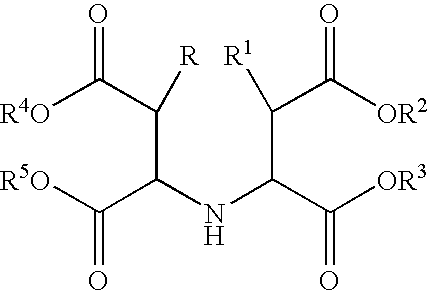Detergent Composition
a technology of detergent composition and composition, which is applied in the field of detergent composition, can solve the problems of unsuitable oligoesters for solid formulations, unsatisfactory cleaning operation, and wet items, and achieve the effect of improving the drying of clean items
- Summary
- Abstract
- Description
- Claims
- Application Information
AI Technical Summary
Benefits of technology
Problems solved by technology
Method used
Image
Examples
example 1
Production of a Polyester to be Used in the Compositions of the Invention
[0119]In a 3-litre four-necked flask with a KPG-stirrer, internal thermometer, gas inlet line and distillation bridge, 281.5 g of 1,2-propanediol, 223.4 g of ethyleneglycol, 202 g of tetraethyleneglycol monomethylether, 582.5 g of terephthalic acid dimethylester and 296.22 g of 5-sulphoisophthalic acid dimethylester-Na-salt were combined, and the reaction mixture was rendered inert by the introduction of N2. 1.02 g of titanium tetraisopropylate and 0.8 g of sodium acetate were then added to the reaction mixture in the reverse direction of flow. The mixture was heated slowly in an oil bath such that, at an internal temperature of the order of 120-150° C., the solid components began to melt. The mixture was than heated to 195° C. within 45 minutes, with stirring. Esterification or distillation began at approximately 173° C. Over a three-hour period, the internal temperature was raised to 210° C., until the requis...
example 2
Production of a Polyester to be Used in the Compositions of the Invention
[0120]The process of example 1 was repeated using the ingredients below to produce another polyester to be incorporated into the compositions of the invention;
280.0 g 1,2-propanediol
241.0 g ethyleneglycol
582.0 g terephthalic acid dimethylester
296.0 g 5-sulphoisophthalic acid dimethylester-Na-salt
143.0 g tetraethyleneglycol monomethylether
0.6 g sodium acetate
1.00 g titanium tetraisopropylate
example 3
Automatic Dishwashing Detergent Composition Comprising a Polyester According to the Invention
[0121]The particulate compositions used to produce each layer were produced according to the formulations given in table 1 using conventional mixing techniques. The particulate material of the first layer was put into the die and compressed. The particulate material of the second layer was added and compressed on top of the first layer but leaving a recess for a ball to be inserted into the upper face of the second (top) layer. The ball was subsequently inserted to produce dual layer detergent tablets with a ball inserted into the top face of the upper layer. These examples are hereinafter referred to as examples 3b and 3c. Example 3c is the example according to the invention and example 3b is a comparative example. The ball was used in both examples 3b and 3c and was injection moulded and is described in table 1. The amounts of particulate material for layers 1 and 2 were added such that th...
PUM
 Login to View More
Login to View More Abstract
Description
Claims
Application Information
 Login to View More
Login to View More - R&D
- Intellectual Property
- Life Sciences
- Materials
- Tech Scout
- Unparalleled Data Quality
- Higher Quality Content
- 60% Fewer Hallucinations
Browse by: Latest US Patents, China's latest patents, Technical Efficacy Thesaurus, Application Domain, Technology Topic, Popular Technical Reports.
© 2025 PatSnap. All rights reserved.Legal|Privacy policy|Modern Slavery Act Transparency Statement|Sitemap|About US| Contact US: help@patsnap.com



